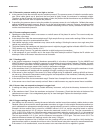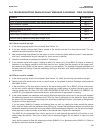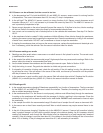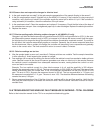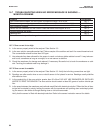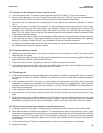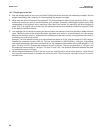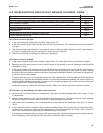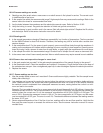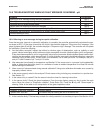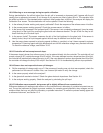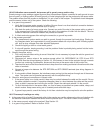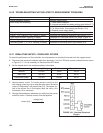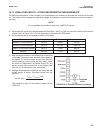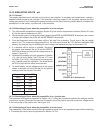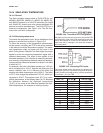
98
MODEL 54eA SECTION 16.0
TROUBLESHOOTING
16.8.4 Process readings are erratic
A. Readings are often erratic when a new sensor or a rebuilt sensor is first placed in service. The current usual-
ly stabilizes after a few hours.
B. Is the sample flow within the recommended range? High sample flow may cause erratic readings. Refer to the
sensor instruction sheet for recommended flow rates.
C. Are the holes between the membrane and the electrolyte reservoir open. Refer to Section 16.8.2.
D. Verify that wiring is correct. Pay particular attention to shield and ground connections.
E. Is the membrane in good condition and is the sensor filled with electrolyte solution? Replace the fill solution
and electrolyte. Refer to the sensor instruction manual for details.
15.8.5 Readings drift
A. Is the sample temperature changing? Membrane permeability is a function of temperature. The time constant
for the 499AOZ sensor is about five minutes. Therefore, the reading may drift for a while after a sudden tem-
perature change.
B. Is the membrane clean? For the sensor to work properly, ozone must diffuse freely through the membrane. A
coating on the membrane will interfere with the passage of ozone, resulting in slow response. Clean the mem-
brane by rinsing it with a stream of water from a wash bottle, or gently wipe the membrane with a soft tissue.
C. Is the sample flow within the recommended range? Gradual loss of sample flow will cause a downward drift.
D. Is the sensor new or has it been recently serviced. New or rebuilt sensors may require several hours to stabilize.
16.8.6 Sensor does not respond to changes in ozone level.
A. Is the grab sample test accurate? Is the grab sample representative of the sample flowing to the sensor?
B. Is the membrane clean? Clean the membrane and replace it if necessary. Check that the holes at the base of
the cathode stem are open. Use a straightened paper clip to clear blockages. Replace the electrolyte solution.
C. Replace the sensor.
16.8.7 Ozone readings are too low.
A. Was the sample tested as soon as it was taken? Ozone solutions are highly unstable. Test the sample imme-
diately after collecting it.
B. Low readings can be caused by zeroing the sensor before the residual current has reached a stable minimum
value. Residual current is the current the sensor generates even when no ozone is in the sample. Because
the residual current is subtracted from subsequent measured currents, zeroing before the current is a mini-
mum can lead to low results.
Example: The true residual current for an ozone sensor is 4 nA, and the sensitivity is 350 nA/ppm. Assume the
measured current is 200 nA. The true concentration is (200-4)/350 or 0.560 ppm. If the sensor was zeroed pre-
maturely when the current was 10 nA, the measured concentration will be (200-10)/350 or 0.543 ppm. The
error is 3.6%. Suppose the measured current is 100 nA. The true concentration is 0.274 ppm, and the meas-
ured concentration is 0.257 ppm. The error is now 6.2%. The absolute difference between the reading remains
the same, 0.017 ppm.
C. Sensor response depends on flow. If the flow is too low, readings will be low and flow sensitive. Verify that the
flow past the sensor equals or exceeds the minimum value. See the sensor instruction manual for recom-
mended flows.



